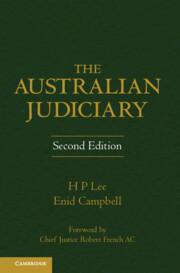Book contents
- Frontmatter
- Contents
- Preface
- Acknowledgments
- Table of Cases
- Table of Statutes
- Chapter 1 Introduction
- Chapter 2 The courts and judges
- Chapter 3 The judiciary as a branch of government
- Chapter 4 Appointment and conditions of service
- Chapter 5 Removal, suspension and discipline of judges
- Chapter 6 Judicial conduct
- Chapter 7 Extra-judicial activities of judges
- Chapter 8 Protecting judicial institutions
- Chapter 9 The accountability of judges
- Chapter 10 A public trust
- Appendix 1 Judicial statistics tables
- Guide to Judicial Conduct
- Index
- References
Chapter 2 - The courts and judges
Published online by Cambridge University Press: 05 December 2012
- Frontmatter
- Contents
- Preface
- Acknowledgments
- Table of Cases
- Table of Statutes
- Chapter 1 Introduction
- Chapter 2 The courts and judges
- Chapter 3 The judiciary as a branch of government
- Chapter 4 Appointment and conditions of service
- Chapter 5 Removal, suspension and discipline of judges
- Chapter 6 Judicial conduct
- Chapter 7 Extra-judicial activities of judges
- Chapter 8 Protecting judicial institutions
- Chapter 9 The accountability of judges
- Chapter 10 A public trust
- Appendix 1 Judicial statistics tables
- Guide to Judicial Conduct
- Index
- References
Summary
The Australian court system
Australia’s legal system is a federal system and one under which power to establish courts is reposed in both the State and the federal Parliaments, and also in the legislatures of the self-governing Territories of the Commonwealth. The courts of the Territories ultimately owe their existence to legislation of the federal Parliament.
While there are distinctions drawn between federal and State courts and between federal and State jurisdictions, the Australian judicial systems are nevertheless integrated, to an extent. This integration has been achieved in several ways: by the establishment of the High Court of Australia as the ultimate court of appeal for Australia; by the use of State courts as repositories of federal jurisdiction; by complementary State legislation, which cross-vests the State jurisdictions of the Supreme Courts; and by constitutional and legislative provisions dealing with the execution of court processes and judgments. There are also institutional arrangements to facilitate the transfer of cases from the court in which proceedings have been initiated to another court when the other court is considered to be the more appropriate forum.
- Type
- Chapter
- Information
- The Australian Judiciary , pp. 20 - 48Publisher: Cambridge University PressPrint publication year: 2012

